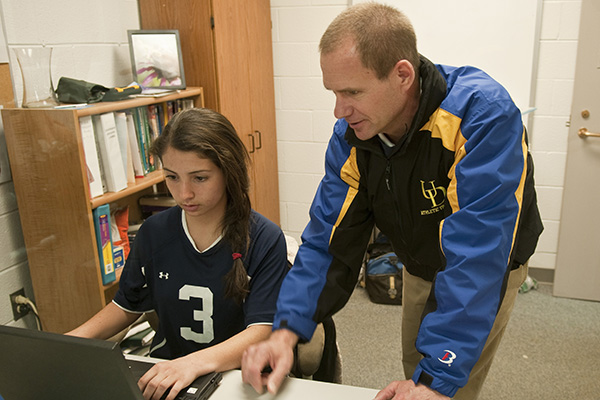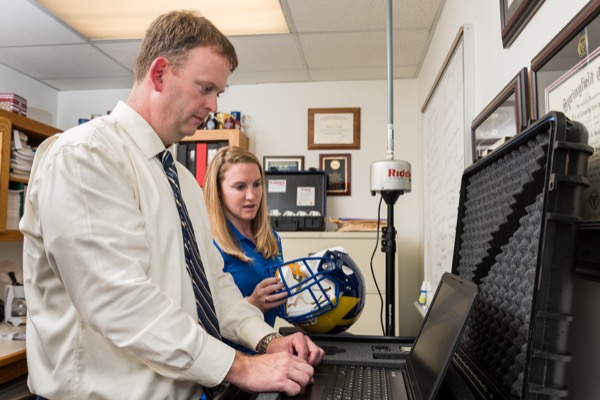


Landmark concussion study
UD student-athletes to participate in study of concussion and head impact exposure
3:07 p.m., March 10, 2015--A team of researchers, coaches and student athletes at the University of Delaware has joined a landmark $23 million NCAA-U.S. Department of Defense initiative to fund the most comprehensive study of concussion and head impact exposure ever conducted.
The research will be managed by the Concussion Assessment, Research and Education Consortium, or CARE. Within CARE, UD is one of 21 schools in the Longitudinal Clinical Study Core, a prospective, multi-institution clinical research protocol led by the University of Michigan.
Research Stories
Chronic wounds
Prof. Heck's legacy
Thomas Buckley and Thomas Kaminski in the Department of Kinesiology and Applied Physiology will lead the research effort at UD, which will include some 600 athletes in 21 sports. UD’s share of the award is almost $300,000 over two years.
“It’s very exciting for us to be part of such a landmark study,” says Eric Ziady, director of athletics and recreation services. “It’s also a testament to the strong infrastructure we have in place here with the ongoing concussion research being carried out by Tom Kaminski and Tom Buckley. Our first priority is the health and safety of our student-athletes, and this study further shows that important commitment.”
Growing concern
Concern about sports-related concussion has grown in recent years, with former professional football players suing the NFL for failing to warn them about potential brain injury and for concealing its dangers.
And it’s not just football.
In September 2014, an autopsy of former Brazilian soccer star Bellini revealed that he suffered from chronic traumatic encephalopathy, the same brain condition found in more than 40 deceased NFL veterans.
“The best concussion is the one you never have,” says Buckley, who currently has support from the National Institutes of Health to track impacts to the head among UD football players using a software system known as HITS. “We’ve gotten much better at assessment and treatment, but we’re not doing enough to predict and prevent concussion.”
“We know that people with a history of depression, anxiety, ADHD and migraines have worse outcomes in terms of concussion,” he adds. “But our hope is that this research, which is aimed at developing a better understanding of the natural history of concussion, will ultimately lead to predictive tools for the occurrence and outcomes of concussion.”
Nationwide evaluations
Through the NCAA-DOD Alliance, an estimated 25,000 male and female NCAA student-athletes will receive a comprehensive preseason evaluation for concussion and will be monitored in the event of an injury.
“The baseline tests include a thorough health history as well as cognitive, balance, visual, and reaction time testing,” says Kaminski, who has conducted research on the effect of ball heading in female soccer players for more than a decade.
“In addition, any athlete who experiences a concussion will undergo a series of five post-concussion screenings, beginning in the acute phase immediately after injury and concluding at the six-month point.”
Scott Grzenda, coach of the UD women’s soccer team, sees UD’s participation in the study as beneficial on a number of levels, including its value as a recruiting tool.
“Through these comprehensive baseline and post-concussion screenings, we’re demonstrating our dedication to the health and safety of our student-athletes,” he says. “The information we glean from the research will also help our team physician and athletic trainers in their efforts to prevent, assess and treat injuries.”
The numbers game
Documenting the occurrence of sports-related concussions is not easy.
Estimates of the number of concussions that occur in the U.S. in sports and recreational activities range from 1.6 to 3.8 million a year, but 50 to 80 percent go unreported. Within a given sport with the same rules — for example, soccer — females tend to report higher rates of concussion than males.
The numbers are also elusive because the diagnostic criteria are everchanging.
“What was a ‘ding’ five or 10 years ago is a concussion today,” Buckley says.
According to a February 2014 NCAA internal report, Self-Reported Concussion among NCAA Student-Athletes, about 16-18 percent of student-athletes will suffer at least one concussion in their collegiate careers. While injuries are more common in contact and collision sports like football and soccer, Buckley emphasizes that they can happen to any athlete.
A Google search of the word “concussion” yields 1.6 million hits in 2.8 seconds. While many of these results point to news about athletes, especially those in the NFL, the military has more than its share of “hits” as well.
Almost 270,000 members of the American military suffered mild traumatic brain injuries between 2000 and 2012, and brain injury has become known as “the signature wound of the wars in Iraq and Afghanistan.”
Although there are some differences between brain injuries suffered on the playing field and those inflicted on the battlefield, soldiers and student-athletes alike stand to benefit from research that sheds new light on the risks, treatment and management of concussion.
“We’re excited to be included in this world-class research study,” says UD football head coach Dave Brock. “Player safety and well-being are paramount at the University of Delaware, and we look forward to participating in a project that benefits not only current student-athletes here at Delaware but others across the country as well.”
Educational grand challenge
In addition to the research, an educational grand challenge is aimed at changing important concussion safety behaviors and the culture of concussion reporting and management.
The immediate goal is to identify a novel, multi-media approach to educating student-athletes, coaches and other influencers about the risks of concussion and the need to report brain injuries in themselves and others.
“With these tools, we hope to encourage better prevention, protection and treatment methods on the sports field and, ultimately, on the battlefield,” says NCAA chief medical officer Brian Hainline.
“Culturally, self-reporting head injuries or reporting others who display head injury symptoms is seen by some a sign of weakness. We hope to change that by arming physicians and scientists with better clinical data and by creating educational programs to increase understanding of the importance of diagnostics for immediate action and tracking for follow-up treatment.”
About the NCAA-DOD Alliance
The research will be managed by the Concussion Assessment, Research and Education Consortium, or CARE, co-chaired by principal investigators at three research institutions:
- Indiana University will serve as the Administrative and Operations Core and will be the central coordination center for the CARE Consortium.
- The Medical College of Wisconsin will direct the Advanced Research Core, which will include cutting-edge studies that incorporate head impact sensor technologies, advanced neuroimaging, biological markers and detailed clinical studies to examine the acute effects and early pattern of recovery from sport-related concussion.
- The University of Michigan will lead the Longitudinal Clinical Study Core, which includes student athletes at the Air Force, Army, Coast Guard, and Naval academies, Princeton University, Virginia Tech, UCLA, Cal Lutheran, Humboldt State, Rochester, Azusa Pacific, and the universities of Delaware, Florida, Georgia, Michigan, Nebraska, North Carolina, Oklahoma, Pittsburgh, Washington, and Wisconsin.
The consortium’s work will expand upon the NCAA National Sport Concussion Outcomes Study, an existing multi-site, longitudinal investigation of concussive and repetitive head impacts in NCAA student-athletes. The Advanced Research Core also will leverage existing collaborative research networks, such as the National Institutes of Health TRACK-TBI and the DoD’s Project Head to Head.
The overall initiative, including the research and educational components, totals $30 million.
Article by Diane Kukich
Photo of Thomas Kaminski by Doug Baker
Photo of Thomas Buckley by Evan Krape










